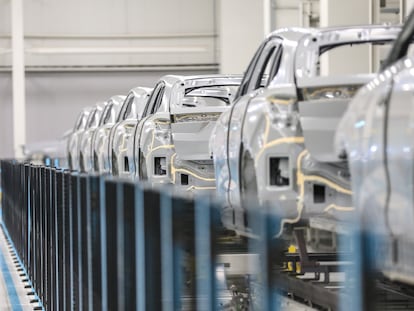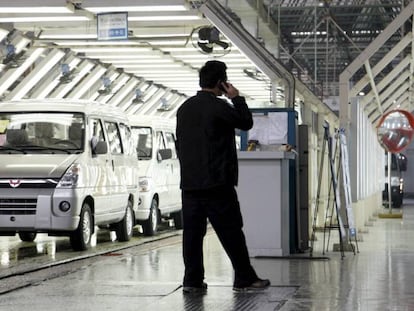In Spain, car factories protect their conversion to electric vehicles with European money
Factory electrification and gigafactories have monopolized the allocation of Next Generation EU funds
In converting the Spanish motor industry to produce battery-powered vehicles, there seems to be no turning back. All the carmakers with an industrial presence in Spain have taken advantage of European aid to secure production lines for batteries. These components alone make up a third of the cost of an electric car. Stellantis, Seat, Ford, and Renault have drawn on the Strategic Project for the Recovery and Economic Transformation for the development of electric vehicles (PERTE-VEC) to jointly secure almost €100 million of non-refundable subsidies. These funds will be used to launch electric battery assembly lines, and three gigafactories that will supply the cells that are connected to those battery arrays. Spain’s Ministry of Industry’s call for tenders closed last week, having achieved its goal of creating a safety net for Spanish factories in the face of disruption in the sector. Automakers needed facilities nearby to save on critical components such as batteries that are heavy and expensive to transport. In this round of funding, €550 million have been distributed, which is added to the €877 million distributed in 2022 in the first round of this PERTE, less than 30% of what was intended, which has forced open new windows of opportunity.
As a counterpart to these investments, projects that are not so close to the vehicle assembly lines have been more discreet. Activities such as extracting and processing minerals or recycling batteries, which might be an important field of business in the future due to the lack of raw materials and the subsequent increase in their cost, account for barely a quarter of the Next Generation funds distributed in this round, which has two parts. One is focused on the electric battery value chain (€550 million in total in addition to credits), and the other is more focused on the production of vehicles and components (€344 million in subsidies and €215 million in soft loans).
“We are very proud of the performance in this round. It is a resounding success and responds to an industrial reality. We have approved 26 projects from 21 different companies and all of them are key to the new industrial revolution,” Héctor Gómez, the acting Minister of Industry, told EL PAÍS. He also highlighted the improvement in automotive jobs and greater “social and territorial cohesion.”
The map of PERTE-VEC aid for the electric batteries sector shows a strategic distribution of the new battery cell factories around the country. The Volkswagen Group gigafactory in Sagunto, which was decided in the first round of the PERTE, will now add the Envision factory in Navalmoral de la Mata and foreseeably the plant that Stellantis will build in Figueruelas. The latter is still pending the allocation of greater public resources having received only €56 million so far, an amount that is a long way off the €200 million to which the Franco-American group aspired. Despite this, these two facilities have absorbed almost half of the non-refundable aid distributed in this round (a total of €528 million, without taking into account the soft loans that were assigned), to which are added other smaller ones. Basquevolt is a project that is notable for its innovative spirit. The company aims to produce more advanced solid-state batteries at its plant in Vitoria, and it will receive €14.6 million to manufacture batteries that provide greater autonomy to vehicles.
The allocated resources (only €21.2 million have been left unassigned, in addition to €187 million in low-interest loans) will accompany investments of billions of euros. Of the 26 approved investments, nine are focused on extracting and processing raw materials and recycling batteries to obtain new resources. That part of the value chain — which a report from the European Court of Auditors called for so as to encourage competitiveness with China and the United States in the field of electric cars — has been left with €123 million, which accounts for a quarter of the total aid from this PERTE window.
Change of criteria in the final phase
This type of investment, further removed from the direct supply to car factories, took a giant step in the latest allocations of funds made by the Ministry’s technicians. BASF’s project to build a new metal refining plant in Tarragona was approved at the end of October with an aid contribution of €15.8 million. Lotte Energy Materials, which will make an investment of €400 million to produce elecfoil (a basic element for battery cells), secured €49.26 million last Wednesday. Previously, both proposals had been rejected and were only rescued after the appeals period had expired. These investments have also been recently added to the plan to produce lithium hydroxide in Cáceres, by Tecnologia Extremeña del Litio, with an allocation of €18.8 million and other projects.
On the difficulty of carrying out industrial ideas that are more independent of auto factories, Luis Romeral, director of the research group on Motion Control and Industrial Applications at the Universitat Politècnica de Catalunya laments: “We have not been able to create a powerful industrial sector and our view of the economy is always so short-term that it costs more to carry out this type of project. With regard to electric car technology, Spain has little to say.” Indeed, the ministry has ended up rejecting various other proposals from BASF, five from Ficosa, and even an investment to build a battery recycling center in Seat.
“Yes, there are initiatives, but it is true that from the investment point of view they are not of great magnitude, but there are projects for components, battery management, or compounds. But it is true that at the level of investment, they are not so attractive,” says Míriam Pérez, director of PWC Consulting. Jordi Esteve, partner of the consulting firm, agrees and remarks that perhaps the time has not yet come for Spain to have all the factors necessary to produce a battery: “Some of these projects may arise in the PERTE-VEC 74,” he says ironically, “or without help, but there will be a time when once you have the two or three cornerstone pieces of the production, you fill in the gaps.”
New help line
Gómez, who has overcome the fear of repeating the fiasco that was the first round for PERTE-VEC, in which barely 29% of the available resources were spent, calls for “not dissociating line A [focused on batteries] from B, which is specifically oriented to the value chain and where we have received 75 investment plans,” and which we expect to have awarded in the first quarter of next year. It is predicted that in that same period, the creation of a new line that is expected to receive the last €1.2-billion tranche of aid for the automotive industry, the distribution of which still does not have clear criteria.
“It will be a line of aid that provides continuity to the existing PERTE and resolves any shortcomings,” explains the Minister of Industry who is optimistic about the distribution of resources that, together, are expected to mobilize €8.6 billion in investments. The novelty of this last line of aid will be that it will be executed through the National Innovation Company (Enisa), a small public entity that had a budget of about €120 million this year. The state business bodies are the oxygen supply that the government has found to enable the time period for companies to make investments to be extended.
Sign up for our weekly newsletter to get more English-language news coverage from EL PAÍS USA Edition
Tu suscripción se está usando en otro dispositivo
¿Quieres añadir otro usuario a tu suscripción?
Si continúas leyendo en este dispositivo, no se podrá leer en el otro.
FlechaTu suscripción se está usando en otro dispositivo y solo puedes acceder a EL PAÍS desde un dispositivo a la vez.
Si quieres compartir tu cuenta, cambia tu suscripción a la modalidad Premium, así podrás añadir otro usuario. Cada uno accederá con su propia cuenta de email, lo que os permitirá personalizar vuestra experiencia en EL PAÍS.
¿Tienes una suscripción de empresa? Accede aquí para contratar más cuentas.
En el caso de no saber quién está usando tu cuenta, te recomendamos cambiar tu contraseña aquí.
Si decides continuar compartiendo tu cuenta, este mensaje se mostrará en tu dispositivo y en el de la otra persona que está usando tu cuenta de forma indefinida, afectando a tu experiencia de lectura. Puedes consultar aquí los términos y condiciones de la suscripción digital.
More information
Archived In
Últimas noticias
Trump clarifies who is ultimately in charge in Venezuela: ‘Me’
Maduro pleads not guilty before the federal court in New York: ‘I am still the president of Venezuela’
A new test can detect Alzheimer’s from a finger prick
UN team enters Sudanese city of El Fasher after paramilitary massacre: ‘It’s like a ghost town’
Most viewed
- Gilles Lipovetsky: ‘If you want to live better and fall in love, take Prozac, don’t look to philosophy’
- Alain Aspect, Nobel laureate in physics: ‘Einstein was so smart that he would have had to recognize quantum entanglement’
- Alvin Hellerstein, a 92-year-old judge appointed by Bill Clinton, to preside over Maduro’s trial in New York
- Why oil has been at the center of Venezuela-US conflicts for decades
- Cuba confirms death of 32 of its citizens in the US attack against Venezuela











































